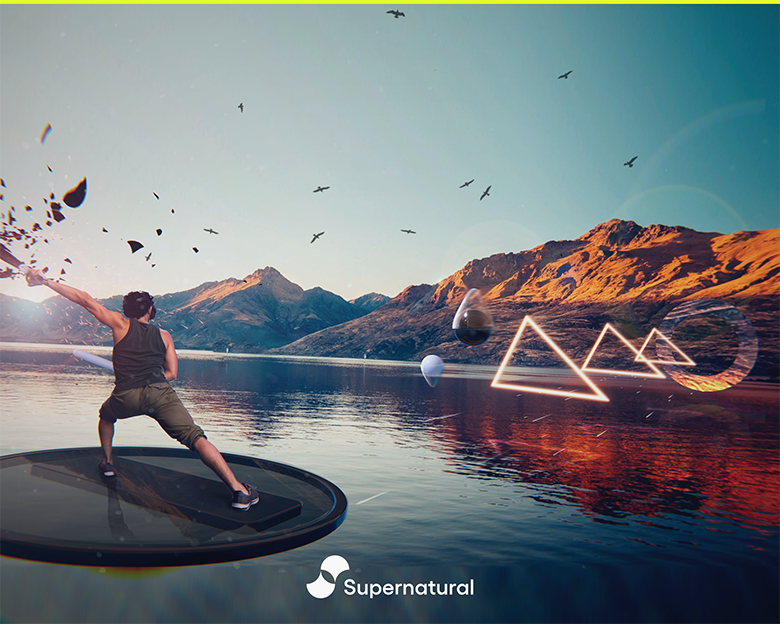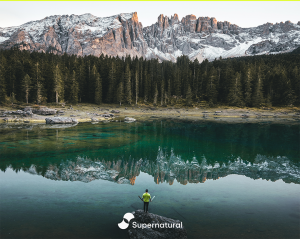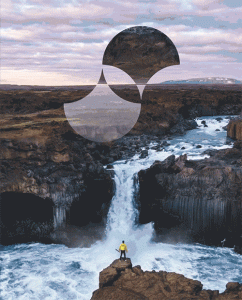Introducing ‘Supernatural,’ a Fun New Way to Stay Fit in VR

Get ready for a cardio workout that’s fun, fast, and intuitive. Supernatural features an unforgettable on-demand workout adventure, and it’s coming to Oculus Quest on April 23.
Building on the beloved mechanics of VR rhythm games, Supernatural is the first app that offers the full fitness package for VR. Designed specifically for fitness, Supernatural serves up daily personalized full-body workouts and expert coaching from real-world trainers. Sweat to music from popular artists and visit beautiful photorealistic landscapes. Track your progress with the companion app, letting you pair your heart rate monitor, schedule workouts, and follow friends for some healthy competition!
Supernatural is a subscription service that offers new workouts published daily. At launch, Supernatural will offer members a discounted introductory rate of $20 USD/month and include a free trial.
We sat down with Within Founder & CEO Chris Milk to learn more.
What was the inspiration behind Supernatural?
Chris Milk: When my Within co-founder Aaron Koblin and I realized we had developed dad-bods without having any actual children, we knew we had to do something. Neither one of us was fond of or good at sticking with exercise. We disliked the rigmarole of going to the gym and didn’t think the home fitness solutions out there were particularly fun. We wanted the benefits of exercising regularly, but we didn’t enjoy the short-term activity necessary to get those long-term results.
So the thing we were desperately searching for did not exist, and we decided to turn all our attention to trying to build it ourselves. We would watch people come out of the interactive VR music videos we were making, laughing and dripping in sweat—we thought maybe there was a solution here in VR. We thought it could solve the main problem we have with exercise; the long-term results don’t outweigh our struggle to do it in the here and now. We started playing our favorite VR rhythm and boxing games as our morning exercise routines. We love these games and will be the first to say they were our inspiration for what we’ve created. We strapped weights and heart rate monitors to ourselves, trying to hack the perfect cardio routine, but none of them were really designed for this purpose. They lacked the sort of health-focused features and metrics you want in a daily exercise platform—things like calibrated range of motion, movements designed for effort expenditure, professional coaching and guidance, heart rate sensor integration, and fitness progress tracking.
How long was Supernatural in development?
CM: Close to two years now. We wanted to come out with a fully formed exercise platform. That meant committing to a broad pipeline of new workouts, the creation of new workouts with new songs in new worlds, and making them available on a daily basis. It takes time, resources, a great team, and a lot of infrastructure to produce daily content, but we knew it was worth the investment.
Equally important is having music you already know and love—music that makes the body move instinctively. It’s so fundamental; we felt there was no way we could compromise and had to launch with it. We wanted people to have that feeling of surprise and delight when a song comes on that they love. The movement maps are essentially gamified dance, and—let’s be honest—you wouldn’t want to go to a club and only dance to songs you’ve never heard before. So we’ve been working and partnering with record labels to craft a deal to use their full catalogs. All these pieces take a lot of time and work, but they were all required to provide a service that was alive, visceral, and continuously updating to give you something new to discover every time you work out.
What sets Supernatural apart from other health and fitness apps?
CM: The home-fitness paradigm, for the most part, means copying what an instructor is doing on a screen. I’ve never taken great joy in that kind of exercise, to be honest. I was a competitive ski racer when I was 15, and skiing is incredible exercise, but I never felt like I was doing “an exercise.” It filled me with exhilaration and joy, and the by-product was exercise and being healthy and in shape. So we set out to make something that felt more like that, only in the footprint of the floor in your bedroom.
Virtual reality offers the unique ability to create an experience like that because it can transport people anywhere. My favorite way to frame it is this: What if you had a wormhole in your closet, and you popped out of bed and dove through it to snowboard in the Swiss Alps every morning, and then popped back through the portal and took a shower and went to work? That reality is possible if you introduce VR into the equation. That’s the emotion we were chasing—something that gives you the physical exercise you’re after, but in a fun, joyous, exhilarating way, and most importantly, you can do it in your home.
One of our coaches, Leanne, calls you “athlete” as a nickname, because working out in Supernatural feels like you’re a champion of a sport from the future. I love that and haven’t felt that sense of athleticism ever on a treadmill or an exercise bike.

How do you think VR and AR will continue to change the realms of health and fitness moving forward?
CM: I fit into the category of “had gym membership, did not use gym membership.” That’s because I wanted the results of doing exercise but disliked the actual act of going to the gym and doing it. I think there are a lot of other people who have a similar relationship with exercise. But exercise doesn’t have to be something painful, laborious, or something you dread—it’s just the methods we use to achieve it that are a bit uninspired.
Virtual reality uniquely allows us to bring you anywhere in the world and beyond. The exercise modalities achievable in VR are also things we could never achieve in the real world as we don’t need to worry about pesky things like the laws of physics.
Another big difference is since this is a 6DOF tracking system, we know how your body is moving through space at all times. And unlike most home fitness systems where you are watching a fixed streaming video clip of an instructor on a screen, we are built in the architecture of an interactive gaming system. That allows us to do a whole host of different things. We are dynamically changing, calibrating, and adjusting to you and what you’re doing in real-time. Right now, that means calibrating to your personal range of motion, i.e., adjusting targets, lunges, and squats based on how your body is comfortable moving. If you have an injury and can reach far to the right but not to the left, the map will adjust the placement of the targets to accommodate.
We also calibrate your personal power range. If you want to get a good workout in VR, you have to put effort into your swings. You can hit a tennis ball with a solid follow-through, or you can flick it with your wrist and let the ball bounce off it. One is a considerably better workout than the other. So we calibrate your personal power range and reward you for hitting in the upper range of it. Everyone’s is surprisingly different, so it’s really about calibration and rewarding the healthy range that’s right for you. Pro-tip: If you see a colored explosion when you hit a target, and a shock wave ring flies off to the horizon, you are hitting in your personal power zone.
We also added in dynamic difficulty: a feature that adjusts the difficulty of the maps in real-time based on how well you’re doing. We’re trying to get you to that magical place where you feel like you are performing just beyond your own capability. It’s that flow state where you stop thinking and are in that zone. You feel like Bruce Lee or Neo, where you’re one with the Matrix.
On the road map is interactive real-time coaching, where the coach is helping you and correcting your form in moments when we see you’re struggling.

Why did you make Supernatural a subscription fitness service?
CM: There are a few reasons. To start with, Supernatural is a completely different kind of experience in that it has been intentionally designed from the ground up as a living VR exercise platform. We built an entire ecosystem that gives people an extraordinary workout experience that gets them excited to come back every day. That includes coaching, a mobile companion app, leaderboards, and Bluetooth heart rate integration. The companion app can also set reminders in your calendar and lets you connect with and challenge your friends. We wanted to make this as intelligent as possible, so it uniquely calibrates to you specifically: your body, your effort, and your optimal heart rate.
Second, every day, our platform generates new content and new value for members, including new workouts, new premium songs, new landscapes and environments from around the world, and ongoing tracking of your progress.
Third, we had the choice of doing a discrete one-time fixed price download with a locked amount of workouts, that would allow you to add more workouts and songs through DLC packs. That works well for games but didn’t feel like the best approach for a fitness system, particularly given one of the big things we are solving for is helping people find, stick with, and ultimately love their exercise program. The platform has been developed in conjunction with fitness experts and behavioral scientists for the purpose of really making a difference in helping people keep on schedule, not get bored with the workout, and not eventually quit.
Most digital fitness services are subscription-based, and there’s a logical reason for that. They need to be because you are not just buying a fixed thing (like a standard exercise bike)—you’re buying access to a living, breathing, dynamic service, one that is constantly producing new workouts with new music. And that requires those companies to be constantly investing every week in all that new programming, which comes with significant costs. We realize there aren’t subscription services in consumer VR right now, and this might be new or surprising for some. But honestly, the only way you can build a premium fitness service like this—with the quality of music and the intensive ongoing creation of fresh workouts, movement maps, and environments, in addition to the 3D capture of a growing team of coaches—is to make it a subscription service.
It’s not that different from Hulu or Netflix or Spotify or a gym for that matter. You’re either pushing advertising or doing a subscription model, and we didn’t think people wanted to watch ads while waiting to work out, but maybe we’re wrong.
Who did you work with to choreograph the workouts? How did you ensure a compelling experience?
CM: This has really been about assembling a technically brilliant, creative, and collaborative team to design the workouts. Our head movement mapper is also a choreographer, and his maps are just incredibly fun to move your body to. They make you feel like you’re really dancing to the music. We also recruited a number of choreographers, trained them to use our in-movement mapping system, and created an infrastructure that lets them map in VR. Not surprisingly, choreographers are naturally good at finding fun ways to move the human body to music.
In addition, we engaged trainers who are featured in Supernatural’s individual workouts, as well as a team of experts in kinesthesiology, biomechanics, and healthy human movement. These experts helped us identify more effective ways to open up and move the body, to achieve smooth, healthy motions. They are a bit more open, fluid, and “flow-y” than what you might have experienced in other rhythm games. We also utilize a really fun triangle tunnel system that gets you to use your lower body doing squats and lunges.
How did your previous work in VR help inform your work on Supernatural?
CM: At Within, we’ve built a lot of interactive experiences that we’ve only released at festivals like SXSW, Sundance, and Tribeca. So a lot of people haven’t seen our recent work in the last few years in the Oculus Store because of that.
Ultimately, VR is about crafting human experience for another person—that’s the medium you’re working with. The block of clay you’re molding is the human experience that someone else is going to have. So if you can give someone any human experience, what do you mold that block of clay into?
For more than a decade, Aaron and I have been making interactive immersive music video projects for artists like Arcade Fire, U2, and Johnny Cash as well as large-scale interactive installation art. We’ve taken everything we’ve learned from those projects and channeled it into this effort. This is the ultimate evolution of an experiential, immersive music video for us and honestly the fruition of many afternoons as a kid standing in front of the TV wildly imitating things I saw on MTV. I don’t watch MTV standing up anymore like I did when I was 8, but adult me could undoubtedly use the cardio I was getting.
What’s the best reaction you’ve seen so far when demoing the app?
CM: We have so many different types of people in early access, with so many different backgrounds. Many have never used VR until this because they weren’t interested in gaming. But they are interested in exercise, so there are some really fascinating people who are the last people you would expect to see in a VR headset but are using it and crushing both Aaron and me on the leaderboard on a regular basis. What’s been universally rewarding is that look on people’s faces when they take the headset off after being in Supernatural … pure joy and exhilaration. Makes it all worthwhile.

What influenced the overall art direction?
CM: We are definitely trying to make the most photo-realistic experience that can run on the current processing power of an Oculus Quest. We’re using high-resolution photo captures of the most amazing places on earth and building out 3D geometry underneath. This gives you 3D stereo vision and a sense of presence that you wouldn’t get if you were looking at a flat photosphere around you.
When you’re building a VR experience, you can obviously go in any aesthetic direction you want. You can go with a more stylized approach, or you can go with a realism approach. We felt like if you’re going to be doing this every day, we wanted to provide a really uplifting, awe-inspiring experience. No one stands at the edge of the Grand Canyon and says, “Yeah, this is kind of bullshit.”
We’ve also recently been experimenting with matte painters who typically create backgrounds for big Hollywood movies. We had them come up with some of their own designs. What does the Grand Canyon look like on a planet in another galaxy?
Who did you work with on the music for the workouts?
CM: The workouts feature some of the biggest artists from the major record labels, and amazing artists from indie labels as well. As a former music video director, I reached deep into all my old music industry relationships to try to get us the best music out there. The right song is like a spell the way it can instantly move you. We really believed we needed the best music period for something like this to work.
Did you encounter any technical challenges? How did you overcome those obstacles?
CM: If somebody wants the list, it’s quite long. Two years long. It’s very difficult to achieve a high level of fidelity and photorealism for so many elements. We spent a lot of time trying to get everything to feel as real as possible.
What’s your favorite part of the experience and why?
CM: I really hope people find what I have found in it. Every morning now, I wake up, roll out of bed, throw on a Quest, and get in a fun, exhilarating state of flow. The dad bod receded, and I feel like I have so much more energy now.
I don’t feel like I ever have to force myself to do it or that it’s a chore or something I have to endure for a greater end goal. It’s something I enjoy in the moment. I never feel like I’m “working out.” Emotionally it feels more like skiing when I was 15 again.
The additional benefit I’ve found is I feel sharper for the rest of the day. A neuroscientist told us that if you get into a flow state first thing in the morning, it’s easier to find that flow state again through the rest of the day. I definitely feel that, and I hope others do as well.
Original Post: Oculus, 4/10/20